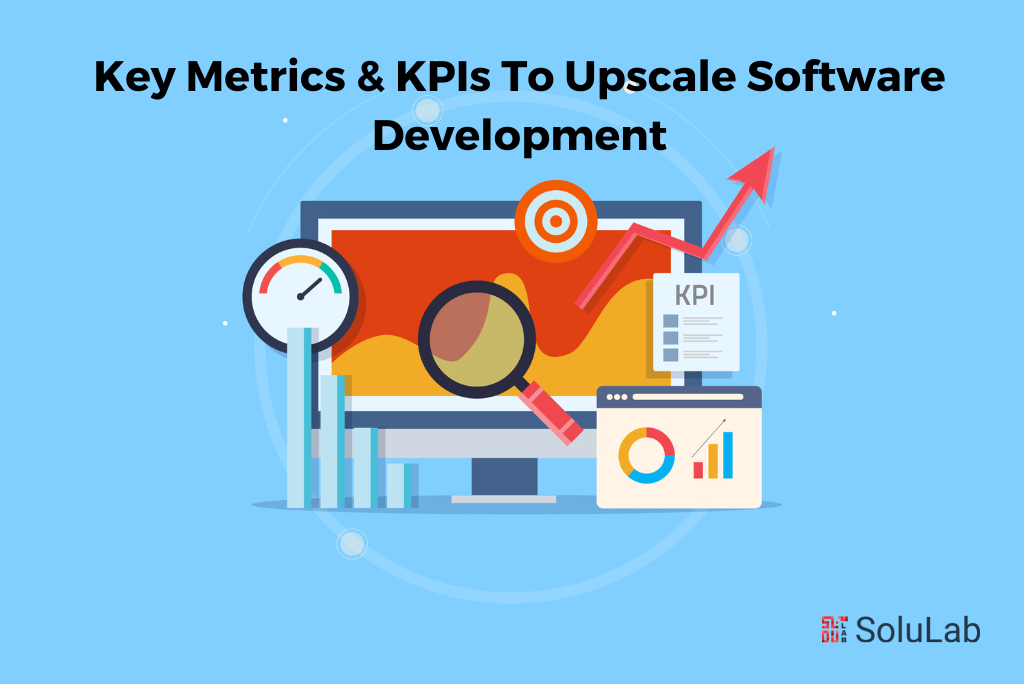
Do you hire a custom software development company to handle your product development because your in-house team is unable to deliver high-quality results? If so, upscaling your software development using key metrics and KPIs may be the perfect solution for you.
Using KPIs and metrics ensures that your business is operating at peak efficiency, giving you a competitive advantage.
KPIs help businesses gain the adaptability they need to set and achieve goals more efficiently.
Whereas key software metrics help businesses identify critical areas for improvement in the software paradigm to fill the void between quality and product development.
So, to put it simply, both play important roles in business for better functioning and a broader reach.
However, many use these terms interchangeably because of their slight difference, which causes firms to use them misleadingly, which again negatively affects development procedures and overall business operations.
This article aims to clarify that very confusion and give readers a real idea of what they are and how they upscale software development. So let’s get things going.
Software Development Metrics
Consider these metrics to be the parameters that provide useful information on how your software products align with your business goals.
In simple words, these parameters are a group of numerical measurements for estimating the quality of the software development process, the development teams’ performance and capabilities, client satisfaction, the time and costs of completing a project, and more.
For a simpler explanation, we can divide the development metrics into two categories.
Project Metrics- measure the effectiveness of teamwork over a specific period for a particular project.
Software Metrics- measure the quality of the product delivered to clients.
Use cases of Software Metrics
Software metrics are important for firms that want to calibrate their business with accuracy to produce quality products, receive an increased number of projects, and enhance collaboration and communication among teams for speedy product delivery.
Here are some of the use cases of software metrics:
- Knowing The better parts of development and management expertise
- Identifying, analyzing, and eradicating flaws in the expertise and development procedures.
- Enhancing operations and development procedures.
- Smartly resourcing the workforce and time by cutting down on unnecessary manpower and procedures with in-effective practice.
- Effective management of development phases and strategizing business operations.
- Enhancing brand image and loyalty.
- Improving client satisfaction and retention.
To sum it up, software metrics focus on analyzing the entire workflow, team productivity, and quality efforts to ensure everything is efficient.
The Reasons to Choose Software Metrics
- To get a better knowledge development team, its effectiveness, and capabilities.
- To easily improve the development team when analyzing weak points and flaws.
- To build elite management and development strategies.
- To accurately schedule each development checkpoint and planning procedures.
- To increase performance, and efficiency by cutting down on unnecessary resources.
- To get a broader view of the company’s overall business perspective.
- To give businesses a competitive edge.
- To retain customers for longer periods.
Key Software Metrics
Companies rely on various software metrics to improve the entire software workflow, which is why it’s crucial to determine metrics depending on what is measured in the software paradigm. Let’s discuss each of the software metrics below.
Developers’ Productivity Metrics
The developer’s productivity metrics assess the software team’s ability to produce quality products within specific time intervals. This key parameter helps companies evaluate the performance and plan possible areas for improvement in software development.
Assignment Scope
Assignment scope is nothing but a team’s overall work in a specific time or assigned time, this could be monthly/yearly.
Active Days
The “active days” are the periods between which a team of developers performs their duties.
Code Churn
The code churn decides how well-versed the development team is, it assesses the number of times the code is rewritten. This means that if churn is high, it is assumed that the developers are inexperienced or lack project understanding.
Agile Teamwork and Practices
Agile methods have set roots for rapid development and deployment among a multitude of companies, and this very parameter determines how these agile approaches have improved development teams’ ability to produce greater results.
Though it’s complex, it has been a promising method that drives profits to the table. Moreover, agile teamwork and practices play a key role in understanding all the metrics mentioned below.
Operational Metrics
Operation metrics are an indicator that lets you track real-time business activities. It’s usable, especially if something goes wrong and businesses need real-time analytics for rapid response to resolve issues.
However, it can also be used for efficient software development outputs and to get insights into the company’s overall day-to-day performance.
Here are two of the most popular operational metrics used in software firms.
Mean Time Between Failures (MTBF)
It represents the average time between repairable software failures.
Mean Time to Recover (MTTR)
It’s the measurement of the time required in the meantime to troubleshoot and repair a failed software element.
Test Metrics
Test metrics are essential to assess the quality of codes and determine flaws in the system. Even though a developer works on coding software, he should employ the built-in testing provided by IDEs.
However, picking test statistics, setting a baseline test, and tracking the performance of the application over a specified period are the best ways to enhance testing.
Test metrics commonly include test coverage, which should always score 100 since it’s a self-check test. Apart from this, the number of automated tests created and conducted and the number of bugs found and repaired are other testing indicators that help improve product quality.
Usability Metrics
It’s not marketing that will give you an edge in users’ hearts but rather the convenience of using your solution. And for this reason, you have to optimize the usability of your solution to an optimal level so everything can be flawless. UI/UX is the very thing that makes it possible, so design and its optimization are a core part of usability metrics.
And it can be determined by,
User Error Rate– The number of times a user makes wrong inputs.
Conversation Rate– The number of users who completed tasks such as filling out the feedback forms or purchasing asset packs.
Customer Satisfaction Metrics
The customer satisfaction metric is among the most critical metrics that businesses can use to provide customers with a greater experience by knowing the areas for improvement.
Net Promoter Score- This indicator is more focused on customer loyalty. It lets businesses determine an accurate customer satisfaction rate across multiple sectors. NPS gives insights into customers’ favorable choices for opting for a particular company’s solution. And based on their responses, businesses can divide users into three categories.
Customer Effort Score – This indicator represents clients’ engagement/involvement in the development procedures. You might have heard of a beta program that is made available for users to test a particular beta solution and give feedback on further optimizations or any features that need to be fixed. It’s quite similar to this indicator.
Read Also: How to Choose The Right Software Development Methodology For Your Business
However, it depends on the client and their desire to test a solution before it is fully made available for mass use. But with this indicator, businesses get insights on their solution much earlier, when it’s still under development, so any fixes can be performed easily without the concern of expensive maintenance.
Key Performance Indicators (KPIs)
The KPIs are nothing but the performance of the value of your overall business, which could be used to evaluate every entity of that business, such as a project, a developer, or a team.
These are aligned with both the short-term and long-term goals of a business, which is why it’s essential to choose the accurate ones to get reliable outcomes.
The Concept of SMART KPIs
The SMART KPI is an enhanced version of traditional KPIs that allows companies to gear up their solutions according to a few factors.
- Specific: They should be specific to a particular goal or purpose
- Measurable: They should be measured in numbers or percentages to evaluate terms
- Attainable: They should be achievable targets
- Relevant: They should be relevant to the software company USA and the industry as a whole
- Timely: They should be time bound to measure over a specific period
Key Software KPIs

Now let’s take a look at some of the KPIs that boost agile development practices to greater heights, allowing businesses to grab more ground and gain huge profits.
Lead and Cycle Time
The lead time can either be the period to deliver a product or the period from a client’s request for a solution to the delivery of requested solutions.
whereas the cycle time is nothing but the time taken by the development team to deliver a requested solution.
Both may sound similar, but lead time is more aligned with the fulfillment of clients’ requests, whereas cycle time is more aligned with the development team’s time to deliver.
Team Velocity
The team velocity is nothing but the number of completed tasks within the sprint sheet.
A sprint sheet consists of tasks for the project that should be completed within an allotted time frame.
Team velocity depends on the sprint sheet of the team, but due to varied tasks and scope, each team’s velocity to deliver and complete the tasks in the sprint sheet varies.
This is why this KPI may not be important enough for some companies.
Sprint Burndown
Sprint burndown is among the important KPIs for scrum teams to get a visual representation of the project’s progress within a given time frame to effectively manage development processes.
It clearly shows how much work has already been done and how much is left, giving an estimate of when the entire project will be done and the parameters that can boost the development.
Open or Close Rates
This KPI shows the number of issues taken for solving, either in progress or closed within a time frame. It can be useful to figure out whether the issues are being assessed and solved regularly for the sake of quality product development.
Cumulative Flow
It is among the critical KPIs for software development. Similar to sprint burndown, cumulative flow is a graphical representation that shows the percentage of work completed or pending that is under review about time.
It can be helpful to get insights into development workflow and task allotment to identify bottlenecks in teams’ capabilities.
How To Bring Optimal Results with Software Metrics and KPIs
Now that you’ve learned about KPIs and software metrics, it’s natural to be confused about which to use and how to use them to achieve the best results. However, using the following points is easy.
Identify Needs, Choose Ideal Metrics and KPIs
The foremost thing you should do is identify what needs you have. By narrowing down your needs, you can get a clear idea of what software metrics and KPIs could help fulfill your business needs.
For instance, quality is among the factors that most companies want. So here you can rely on developers’ productivity metrics, among others, to improve the quality of products.
Plan Implementation of Metrics and KPIs
Now that you know which metrics and KPIs to use, you need to plan their implementation in your procedures and take the necessary measures to ensure they are followed by each team to get data-driven insights for further assessment.
Track Progress
Track the progress of your product development and team performance using KPIs such as sprint burndown and cumulative flow to gain insights on the tasks and strategize each area for improved operations.
Read Also: A 5-Step Guide To Successful Software Development Outsourcing
Keep on Improving
Once you start getting results, whether they are bad or good, keep on improving by assessing each area with metrics and KPIs. You can even try out other KPIs to see if they add more value. Thus, you will be on a continuous track of improvement and will soon reach the potential you require.
Conclusion
There you have the key metrics and KPIs to upscale software development.
There are many different software metrics and KPIs to improve your software development process and team’s performance for quality product delivery. Especially when businesses are leaning toward agile methodologies for faster development and deployment to accelerate rapid transformation.
However, these are powerful parameters and should only be used by experts who know its key areas and how to use them for optimal results.
And if you don’t have such an expert, then you should rely on a software firm such as Solulab, whose development teams utilize the best software metrics and KPIs to produce quality products way ahead of the deadline.
FAQs
What Are KPIs And Metrics?
Though you may find sources that use these words interchangeably, KPIs and metrics are different parameters that evaluate the overall performance of your business.
KPIs- assess business performance by evaluating areas for development.
Metrics- these evaluate the elements of the development process, such as team, program, and testing, for a quality product that aligns with business goals.
Why Are KPIs And Metrics Important for Software Development?
KPIs and metrics are important in software development as they contribute to achieving great success. Using KPIs and metrics, you can evaluate development aspects, the team and its capabilities, and other areas for improvement to optimize each entity and better align them with your business goals.
Which KPIs Are Crucial For Software Development?
Sprint burndown and cumulative flow, lead, and cycle time is among the most crucial KPIs for software development.
Which Software Metrics Are Important For Software Development?
Developer productivity metrics, operational metrics, test and usability metrics, and customer satisfaction metrics are among the important software metrics for software development.




